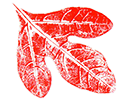
Many people live in apartments or other locations where they aren’t able to plant large flower beds or gardens. Their gardening efforts may be restricted to a few containers on a small patio. I talk to people all the time who want to do something for the pollinators, but don’t feel like it is an option because they don’t have much gardening space. The good news is they are wrong. There are plenty of plants that can be grown in containers that will benefit pollinators. Below are a few of my favorite types of plants to consider for pollinator container gardens.
1) Culinary herbs and garden vegetables
Culinary herbs and garden vegetables are usually my first recommendation for people who have very small spaces. My reasoning is that if you only have a small space, then you need that space to do as much as possible. Culinary herbs and garden vegetables will do double duty – they feed the gardener and the pollinators.
Thyme, basil, oregano, mint, and rosemary are all examples of culinary herbs whose flowers will be visited by butterflies and bees. Once the herbs go to flower, they begin producing less of the oils that make them good for cooking. So, pinch off the flower buds while you are still using the herbs, but when you get sick of harvesting and freezing basil or any of the other herbs, let them flower and enjoy watching the pollinators use the flowers. Parsley and dill are other culinary herbs that pollinators will use, but this time you are providing baby food for the butterflies because these plants are host plants to many species of caterpillars.

2) Some native plants
Native plants are typically my number one recommendation for planting for pollinators because they are the natural food source for our native pollinators. However, native plants typically have long root systems that can make them less well-suited to container gardening. Having said that, there are some species of native wildflowers that can be grown for several years in containers. Purple coneflower, grey-headed coneflower, lance-leaved coreopsis, mountain mints, and many of the fall asters are all examples of native wildflowers that can be grown in containers. Butterfly milkweed can also sometimes last a few years if given a larger container with well-drained soil.

3) Old-fashioned annuals
Annuals like zinnias, calendula, cupheas, alyssum, and cypress vine are just a few of the ornamental annuals that are attractive to pollinators and can be easily grown in containers. When choosing annuals for pollinators, lean towards the old-fashioned and wild-type cultivars because they sometimes have better nectar and pollen production than some of their newer cultivar cousins.
So don’t be afraid to try container gardening for pollinators if you want to plant for pollinators, but don’t have much space. The trick is to pick plants that fit your space and individual needs, but that’s the also trick for more traditional, in-the-ground pollinator gardens. One advantage of container gardens over more traditional gardens is that if you try a species and it doesn’t do well in a container, then it is really easy to replace it with something else. The important thing to remember is that everyone can do something for pollinators, no matter how small or large your space is.

This article was part of Shannon’s original Kentucky Pollinators and Backyard Wildlife blog which evolved into the blog for Backyard Ecology.

Backyard Ecology: Exploring Nature in Your Backyard
Nature isn’t just “out there.” It’s all around us, including right outside our doors. Hi, my name is Shannon Trimboli, and I am the host of Backyard Ecology. I live in southcentral Kentucky and am a wildlife biologist, educator, author, beekeeper, and owner of a nursery specializing in plants for pollinators and wildlife conservation. I invite you to join me as we ignite our curiosity and natural wonder, explore our yards and communities, and improve our local pollinator and wildlife habitat. Learn more or subscribe to my email list at www.backyardecology.net.

Leave a Reply